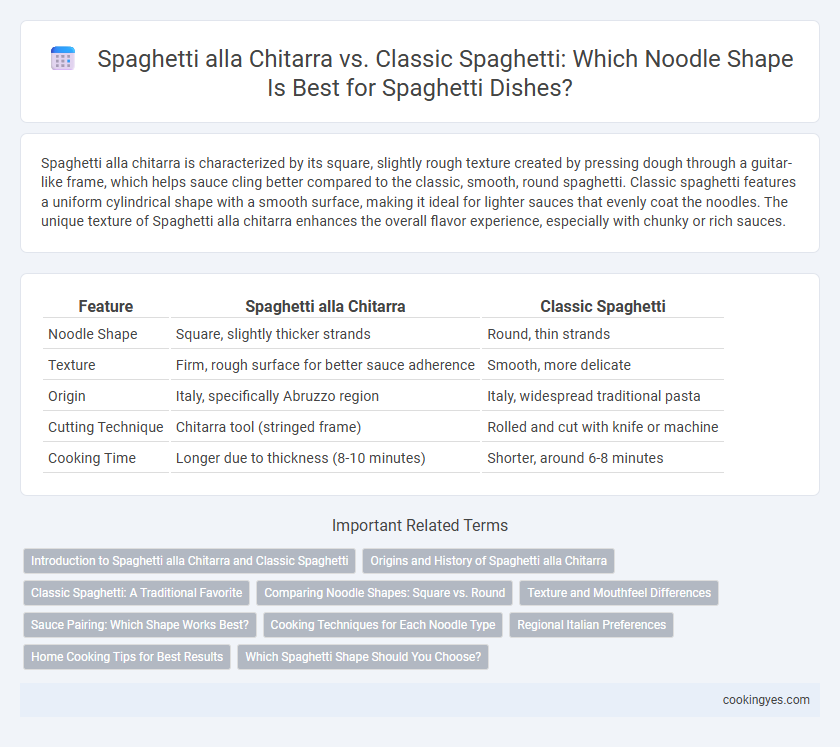Spaghetti alla chitarra is characterized by its square, slightly rough texture created by pressing dough through a guitar-like frame, which helps sauce cling better compared to the classic, smooth, round spaghetti. Classic spaghetti features a uniform cylindrical shape with a smooth surface, making it ideal for lighter sauces that evenly coat the noodles. The unique texture of Spaghetti alla chitarra enhances the overall flavor experience, especially with chunky or rich sauces.
Table of Comparison
| Feature | Spaghetti alla Chitarra | Classic Spaghetti |
|---|---|---|
| Noodle Shape | Square, slightly thicker strands | Round, thin strands |
| Texture | Firm, rough surface for better sauce adherence | Smooth, more delicate |
| Origin | Italy, specifically Abruzzo region | Italy, widespread traditional pasta |
| Cutting Technique | Chitarra tool (stringed frame) | Rolled and cut with knife or machine |
| Cooking Time | Longer due to thickness (8-10 minutes) | Shorter, around 6-8 minutes |
Introduction to Spaghetti alla Chitarra and Classic Spaghetti
Spaghetti alla chitarra features a square cross-section created by pressing dough through a stringed frame called a chitarra, resulting in a firmer texture that holds sauces well. Classic spaghetti has a round, cylindrical shape produced by extrusion through a die, offering a smooth surface and slightly softer bite. The distinct noodle shapes influence the overall mouthfeel and sauce adherence, making each variety unique for different culinary applications.
Origins and History of Spaghetti alla Chitarra
Spaghetti alla chitarra features square, thicker strands created using a wooden frame called a chitarra, originating from the Abruzzo region of Italy. This traditional method dates back to at least the 18th century, reflecting rustic Italian culinary heritage distinct from the classic round spaghetti shaped through extrusion. The unique texture of Spaghetti alla chitarra allows it to hold rich, hearty sauces better, emphasizing its historical role in southern Italian cuisine.
Classic Spaghetti: A Traditional Favorite
Classic spaghetti features a smooth, cylindrical shape that allows sauces to cling evenly, preserving a traditional Italian dining experience. Unlike Spaghetti alla chitarra, which has a square cross-section and a slightly rougher texture, classic spaghetti offers a delicate bite and versatile use with a wide range of sauces. Its iconic round form makes it a staple in many classic pasta dishes, maintaining its status as a beloved favorite worldwide.
Comparing Noodle Shapes: Square vs. Round
Spaghetti alla chitarra features a distinctive square shape achieved by pressing dough through a chitarra frame, providing a firm texture that holds sauces effectively. Classic spaghetti, with its traditional round shape, offers a smoother surface ideal for lighter, oil-based sauces. The square edges of Spaghetti alla chitarra increase surface area, enhancing sauce adherence compared to the round strands of classic spaghetti.
Texture and Mouthfeel Differences
Spaghetti alla chitarra is characterized by its square cross-section and rough texture, which allows it to hold sauces more effectively and provides a chewier mouthfeel compared to classic spaghetti's smooth, cylindrical shape. The rough surface of spaghetti alla chitarra enhances sauce adhesion, creating a more flavorful bite, while classic spaghetti offers a silkier, more delicate texture that glides gently over the palate. These textural differences influence the overall dining experience, making spaghetti alla chitarra ideal for hearty sauces and classic spaghetti suited for lighter, finer preparations.
Sauce Pairing: Which Shape Works Best?
Spaghetti alla chitarra features a square, slightly thicker strand that holds chunky and hearty sauces, such as ragu or meat-based sauces, more effectively by allowing the sauce to cling to its edges. Classic spaghetti, smooth and round, pairs best with lighter, smoother sauces like marinara or aglio e olio, as its sleek surface lets delicate flavors evenly coat each strand. Choosing between the two pasta shapes depends on sauce texture: thick, robust sauces benefit from the textured grip of spaghetti alla chitarra, while thin, simple sauces complement the classic spaghetti's roundness.
Cooking Techniques for Each Noodle Type
Spaghetti alla chitarra features a square cross-section due to being cut with a chitarra tool, offering a thicker, firmer texture that holds up well to bold sauces and requires slightly longer cooking times than classic spaghetti. Classic spaghetti has a round, slender shape that cooks quickly and evenly, making it ideal for lighter sauces and dishes needing delicate pasta strands. Cooking techniques for spaghetti alla chitarra involve careful timing to ensure an al dente bite, while classic spaghetti demands constant stirring to prevent clumping and overcooking.
Regional Italian Preferences
Spaghetti alla chitarra, originating from Abruzzo, features a square cross-section and firmer texture due to being cut with a chitarra tool, making it ideal for hearty, meat-based sauces common in Central and Southern Italy. Classic spaghetti, known for its smooth, round shape, is preferred throughout Italy for its versatility, especially in dishes with lighter, tomato-based or seafood sauces popular in Northern regions. Regional Italian preferences highlight the pairing of Spaghetti alla chitarra with robust flavors, while classic spaghetti adapts well to a broader range of traditional Italian recipes.
Home Cooking Tips for Best Results
Spaghetti alla chitarra features square, thicker strands that hold sauces differently than the round, thinner classic spaghetti, making it ideal for hearty, chunky sauces in home cooking. For best results, ensure spaghetti alla chitarra is cooked al dente to preserve its firm texture, while classic spaghetti requires constant stirring to avoid clumping. Using ample salted boiling water helps maintain the noodles' shape and texture regardless of the type.
Which Spaghetti Shape Should You Choose?
Spaghetti alla chitarra features a square-shaped cross-section with a slightly rough texture, allowing sauces to cling better compared to the round, smooth classic spaghetti. Choosing spaghetti alla chitarra enhances dishes with chunky or creamy sauces due to its increased surface area, while classic spaghetti works well with lighter, oil-based sauces because of its slender, uniform shape. Selecting the right spaghetti shape depends on the sauce texture and the overall mouthfeel you desire.
Spaghetti alla chitarra vs Classic spaghetti for noodle shape Infographic

 cookingyes.com
cookingyes.com